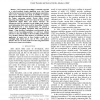Free Online Productivity Tools
i2Speak
i2Symbol
i2OCR
iTex2Img
iWeb2Print
iWeb2Shot
i2Type
iPdf2Split
iPdf2Merge
i2Bopomofo
i2Arabic
i2Style
i2Image
i2PDF
iLatex2Rtf
Sci2ools
CIBCB
2006
IEEE
2006
IEEE
Machine Learning in Basecalling Decoding Trace Peak Behaviour
— DNA sequence basecalling is commonly regarded as a solved problem, despite significant error rates being reflected in inaccuracies in databases and genome annotations. These errors commonly arise from an inability to sequence through peak height variations in DNA sequencing traces from the Sanger sequencing method. Recent efforts toward improving basecalling accuracy have taken the form of more sophisticated digital filters and feature detectors. We demonstrate that the variation in peak heights itself encodes novel information which can be used for basecalling. To isolate this information for a clear demonstration, we perform a peculiar blind basecalling experiment using ABI processed output. Using classifiers responding to measurements in the context of the basecalling position, we call bases without reference to the peak heights at the basecalling position itself. Tree classifiers indicate which features are pertinent, and the application of neural nets to these features results...
| Added | 10 Jun 2010 |
| Updated | 10 Jun 2010 |
| Type | Conference |
| Year | 2006 |
| Where | CIBCB |
| Authors | David Thornley, Stavros Petridis |
Comments (0)

